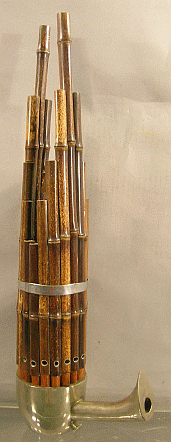 |
||||||||
Sheng |
||||||||
 |
Sheng (Mouth Organ) multi-pipe bamboo instrument with keys
and a metal resonating pot ... contemporary form of an ancient Chinese
instrument. 21" H x 8" W x 3.5" diameter (Pictured). Whilst the below extract from Wikipedia is excellent, it does not specify which ordinary people actually play forms of this instrument today. It is a very common instrument across all of Southern China, and tends to be favoured by rural people and Ethnic Minorities. Supplementary to the great description below, please know that simple forms are usually hand-made by villagers from local bamboo groves, and consist of far fewer pipes, normally between six and twelve. Please consider versions bought from Hawkers to be of little ornamental value only, and should not be considered as musical instruments... The Chinese sheng (Chinese: 笙; Pinyin shēng) is a mouth-blown free reed instrument consisting essentially of vertical pipes. Traditionally, the sheng has been used as an accompaniment instrument for solo suona or dizi performances. It is one of the main instruments in kunqu and some other forms of Chinese opera. Traditional small ensembles also make use of the sheng, such as the wind and percussion ensembles in northern China. In the modern large Chinese orchestra, it is used for both melody and accompaniment. Its warm mellow sound expresses lyrical melodies well, while its ability to play chords makes it a highly prized accompaniment instrument. The sheng has been used in the works of a few non-Chinese composers, including Lou Harrison, Tim Risher, Brad Catler, and Christopher Adler. Some believe that Johann Wilde and Pere Amiot traveled to China and brought the first shengs back to Europe in 1740 and 1777 respectively, although musical instruments similar to shengs were known in Europe centuries earlier |
|||||||
| Shengs are broadly classified into two categories: traditional
sheng (传统笙; pinyin: chuántǒng shēng) and keyed sheng (键笙; jiàn shēng).
Keyed shengs have only been developed in modern times, c. 1950 onwards. Traditional sheng (传统笙, pinyin Chuántǒng Shēng) The traditional sheng is the original type of sheng, which has seventeen, twenty-one, twenty-four or thirty pipes (depending on maker, model and regional culture). Uses treble clef when in western notation, but more often uses jianpu, Chinese numerical notation. The difference between a traditional and keyed sheng lies in its mechanism. On a traditional sheng, the holes on the finger pipes are pressed directly by the player's fingers. On a keyed sheng, the holes are opened and closed by means of keys or levers. Without keys, the great number of pipes and the size of the alto to bass instruments makes it impractical for operation by hand. Covering a hole causes the entire length of the pipe to resonate with the reeds' frequency. If the hole is open, the resonance frequency would not match, and hence no sound is produced. Keyed sheng Currently, there are four main ranges of keyed sheng, forming a family of soprano, alto, tenor and bass. All of them are chromatic throughout their range, and tuned to the equal temperament scale. Gaoyin sheng (高音笙, pinyin Gāoyīn Shēng) 36-pipe sheng with a soprano range of G3 to F#6 (Taking middle C = C4). Uses treble clef Zhongyin sheng (中音笙, pinyin Zhōngyīn Shēng) 36-pipe sheng with an alto range of C3 to B5. Perfect 5th lower than Gaoyin sheng. It has an additional row of 12 keys coloured in black, which when depressed plays all 3 pipes corresponding to the same note in different octaves. E.g., pressing the black "C" causes the notes C3, C4 and C5 to be sounded simultaneously. Uses treble and alto clefs. Cizhongyin sheng (次中音笙, pinyin Cìzhōngyīn Shēng) 36-pipe sheng with a tenor range of G2 to F#5. One octave lower than soprano sheng. Uses alto clef, or treble clef transposed down an octave. Note: Cizhingyin sheng can also be used as Diyin sheng if you don't want to buy one. Diyin sheng (低音笙, pinyin Dīyīn Shēng) 32-pipe sheng with a bass range of C2 to G4. Uses bass clef. Information extracts and image reproduced from Wikipedia under 'Collective Commons License' http://en.wikipedia.org/wiki/Sheng_(instrument) |
||||||||
|
||||||||